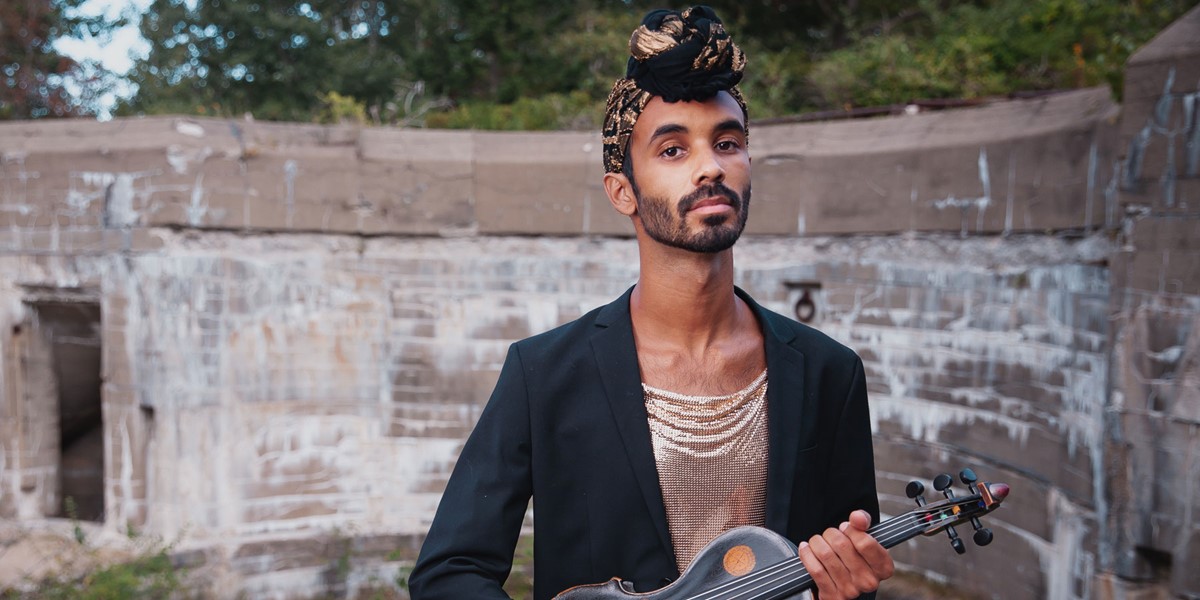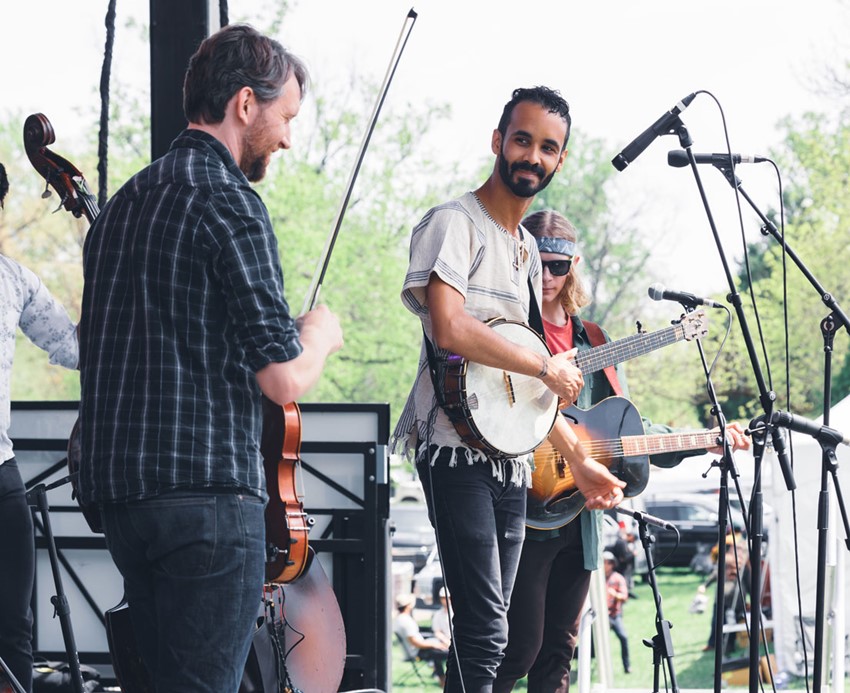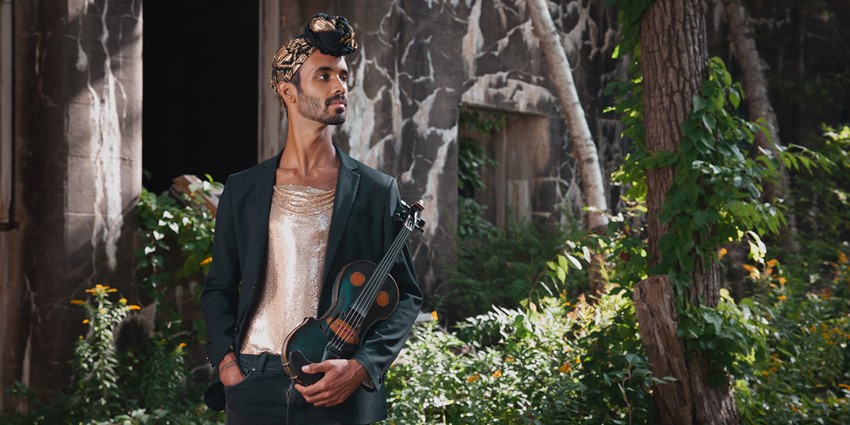Thursday, November 24, 2022
Jake Blount interview: “I wanted to find a way to represent our traditions while also looking forward”
American banjo and fiddle player Jake Blount explains to Alexandra Petropoulos how he’s using the sounds and lessons of history and the global climate crisis to envision a new future for Black spiritual music

Jake Blount (photo: Tadin Brego)
The New Faith starts with a prayer. ‘We gather here today to confess and be cleansed in the eyes of our creator,’ American musician Jake Blount speaks in soothing tones over a bed of humming. It’s a conventional prayer, speaking on the sins of humanity. It is timeless and could have been lifted from a Black church service at any point in US history. But when the background humming shifts into a more aggressive, rhythmic chant – ‘judgement, judgement bar’ – that timelessness falls away and we are cast into a future that we may already have doomed ourselves to. ‘Our forefathers took without giving, took without need – took things that they had neither desire nor use for, and threw them away. They covered the face of the ancient planet in newborn desert. They melted the ice at the ends of the earth, drowned the coast, emptied seas and forests of life, filled the very oceans with fire. And were judged.’
Inspired by the Afro-futurist novels of Octavia Butler and NK Jemisin, The New Faith is a concept album, an imagined field recording of a religious ceremony held by a group of Black climate refugees, marooned on an island off the coast of Maine after the collapse of civilization. As we’re guided through the service, we are visited by songs that feel familiar but slightly off-kilter as if remembered from a dream. Recognisable lyrics are given new meaning – is Sister Rosetta Tharpe’s ‘Didn’t It Rain’ about the Great Flood of the Bible or a cataclysmic event witnessed by these hypothetical survivors?

Jake Blount (photo: Matt Ruppert)
“I was reading a lot of [Butler and Jemisin] at the time when I had this idea,” fiddle and banjo player Blount says, “and I would credit a lot of the feeling of urgency around the climate to reading [Butler’s novel] Parable of the Sower. I was really inspired by the idea that it was still worth imagining the future, even when it looked that bad. And cognisant of how big an impact [that story] had on me, I wanted to find a way to represent our traditions while also looking forward.”
The New Faith reaches deep into the past, using found songs to help imagine the future, one in which survivors praise their luck with a mix of folk, gospel and blues drawn from a time well before their era of rebirth. The album reaffirms the importance of spirituals in their ability to solidify a sense of community and draws parallels between the painful history of Black Americans and the horrors that all of humanity is doomed to face if we don’t address the climate crisis. I’m tempted to call it a dystopic cautionary tale, but Blount isn’t so convinced. “A dystopia is not just a wasteland but a failed utopia. Something that people did to try to make a perfect world and it inevitably went wrong. A dystopia is something that requires making and breaking a universe, [The New Faith] was just about following the trends in our world to their logical conclusions. I didn’t try to push anything to an extreme. In fact, I would argue I have been pretty optimistic in that there are still people alive that far into the future in the world I’ve created.”
So, maybe not dystopic, but certainly a cautionary tale, a project that forces us to face hard truths. But Blount is no stranger to hard truths. His debut album Spider Tales (2020) mined the American tradition in an attempt to recognise the contributions of countless Black artists whose music has been colonised into the Americana canon and whose voices have all but been erased from history. The album was a haunted journey through traditional material, fuelled by the pain, anger and fear of our times – it was released only four days after George Floyd’s murder. “Spider Tales really came out of a desire to recognise the contributions of these people who have not received the credit they were due, and recognise that there is this whole tradition in history that has been deliberately erased from our conversations about folk music.”

Jake Blount (photo: Tadim Brego)
“We often get a two-dimensional picture of enslaved Black people in American history: they were downtrodden and miserable, which of course they were. But I don’t think we pay enough mind to the small acts each one of them had to make in a given day to reaffirm their own humanity. So much of that has been lost because they couldn’t write things down. Even if they were able to read or write, which was rare, they would have been punished for it. So, these songs are the best that we have, and I think my connection to this music has always been in wanting to find out more about what it was like to live in times other than this one.”
And like Anansi, the trickster spider of African myth that inspired the album’s name, Blount teases out a silk thread from Spider Tales and follows those silenced voices from the past, through the present and into the future. For The New Faith, he explains, “I’m working with a lot of music that comes from a similar time period and similar cultural context. But I think [with Spider Tales] I had strongly made the point of, ‘these people were here. They were making this music and we’re still here and we’re still making the music.’ It’s still a living, breathing tradition.” The New Faith is about taking that a step further and asking the question, “what the music will look like as we as a people continue.”
He explains that the refugees of his world share similarities with these ancestors. “This is a group of Black people who have been confined to a particular space… And I can’t think of a time in this country’s history when Black people have been incarcerated or confined and music hasn’t sprung up to deal with the situation. It’s just part of who we are and what we do when we’re put in those dire situations.”
This thought experiment did come with its challenges, including deciding on what instruments this imaginary community might still have available to them. The album’s co-producer, Brian Slattery, suggested using found percussion like a trashcan lid or bottle. “I was like, I don’t see a future where Black people don’t know how to make drums. That doesn’t feel real to me. So, we put drums back on the table.” What he felt sure would be left, however, were the songs, the spirituals that had been passed down through the ages, and had even found a home within Blount himself, a self-professed “unlikely devotee.”
‘I only rarely attended church as a child,’ the liner notes read, ‘declared myself an atheist at the tender age of eight and developed a strong antipathy toward Christianity when I began to understand my queerness. Nonetheless… [i]n moments of homesickness, sorrow and fear, [spirituals] are the songs I turn to for solace.’ But while many of the songs on the album may be identified as spirituals, there’s a tricksy vagueness to many of the words that give them a cheeky whiff of mythology. None of the songs reference God or Jesus and ‘Death Have Mercy’ addresses Death as a character, an entity to be entreated. “That’s not something Christian people do. Death isn’t a deity in Christian theology.” The listener is left to make their own conclusions about who the congregation are singing to, be it God, a pantheon of old gods, or maybe even new gods born of the climate catastrophe. “I didn’t want to be specific about whether or not Christianity had survived, just that these are things that have been passed down and recontextualised, and continue to be relevant even as the circumstances attached to them change.”
He felt it was important to not recontextualise a song in a way that came into conflict with its original context. “I don’t love when people sample chain gang music and then turn it into a pop song, because it completely disregards where the music came from and who was singing it and why. I want to be clear that I have a lot of respect for the people that it’s coming from.”
Though there are some newly written lyrics, including some excellent rapping from Demeanor on a few tracks, for the most part the songs featured on The New Faith have been collected from the past, either from print sources or audio recordings (“I owe a large debt to Alan Lomax”). So how did he approach collecting the songs that told his story? “It was a different process depending on the song. Some of them were very intuitive. I heard ‘Didn’t It Rain’, and I was like, oh that’s literally about catastrophic storms swallowing the earth.” The lyrics, full of the characteristic repetition of spirituals, are sung over a banjo ostinato punctuated by handclaps, bottle clicks and a simple drum. The bluesy guitar certainly summons Sister Rosetta Tharpe’s spirit from her historic Chorlton train station gig.
Other songs seemed to resonate just as well with the concept. The heart-breaking ‘Tangle Eye Blues’ for example, which repeats the mournful line ‘Lord, I wonder will I ever get back home’ over a single crying fiddle line, or ‘City Called Heaven’ which starts ‘I am a poor pilgrim of sorrow tossed in this wild world alone.’ Another, the final ‘Once There Was No Sun’, felt relevant, though it was hard to place a finger on exactly why until after recording it. “[It’s] an interesting song because it doesn’t have a plot. It doesn’t urge to us any one understanding of what it means.” The Bessie Jones recording he learned it from starts with a reading from Genesis, the time before the creation of light. “It felt that this is a song about the music of the spheres and these elemental truths of our world. It felt significant because I’m talking about the impermanence of us and trying to urge us to pay more mind to the needs of the planet. [The song] addressed those things somehow, but I wasn’t exactly sure how. I think the way that I’ve come to understand the song is as a reminder that, once there was no sun, once there was no moon, once there was no light. The implicit message is, and there might not be. We’re so lucky to have this now, it could go away any time.” A reminder to be grateful for what we have.
The album is organised into three parts – The Psalms of the Sentinel, The Psalms of the Gravedigger and The Psalms of the Teacher. Each begins with the album’s only newly written material: a prayer, ‘Parable’, and ‘Psalms’ respectively. “It started out that we were being pretty loyal to these old field recordings of Black religious services, which often will include people praying in between songs. And there will be people humming while somebody speaks. It’s a wonderful sound.” On opener ‘Take Me to the Water / Prayer’ the harmonies of the spiritual give way to a spoken prayer to start the service. Now that the party had been started, Blount wondered, “do we believe they’re going to stop playing for somebody to talk in the middle of the thing? And that’s why, on the remaining tracks, there’s always somebody playing something, whether it’s just the violins on ‘Parable’ or the incredibly intense drumming on ‘Psalms’.”
Imagined as a field recording from the future that has somehow managed to find its way back in time, the songs of The New Faith were recorded to feel as if it were everyday, ordinary people attending their church service. “There were times when I was like, ‘I don’t know if that’s perfect, I want to redo it.’ And Brian was like, ‘no, this is a really hard vocal line. I don’t believe it’s realistic that someone would have done it completely in tune in the world that you’ve just created. These aren’t professional musicians’.” This meant recording in a free and spontaneous manner, letting the songs live and breathe their own truth. ‘Didn’t It Rain’, for example, slowly creeps down from E to E flat over the course of the song. “There’s a whole half step of key drift in the song, which bugged the crap out of some people. I knew it was there and I just didn’t care. It sounded right to me.”
And these songs do fizz with life. As much as we can reach into the past with these spirituals to connect to those who came before us, here we are offered a rip in time and space for a chance to whisper to our descendants, ‘we’ll try harder.’ “It’s not something that I’ve thought of as a didactic album. I didn’t make it to teach people something, necessarily. It was just about exploring, but exploring is how we learn. For me the key element is that this is one version of the future under climate change. And that I hope that people listen to this and go, ‘it doesn’t sound like they’re having a good time, maybe we should stop’.”
Read the review: Jake Blount's The New Faith, one of Songlines' 10 Best Albums of 2022
This interview originally appeared in the November 2022 issue of Songlines magazine. Never miss an issue – subscribe today

